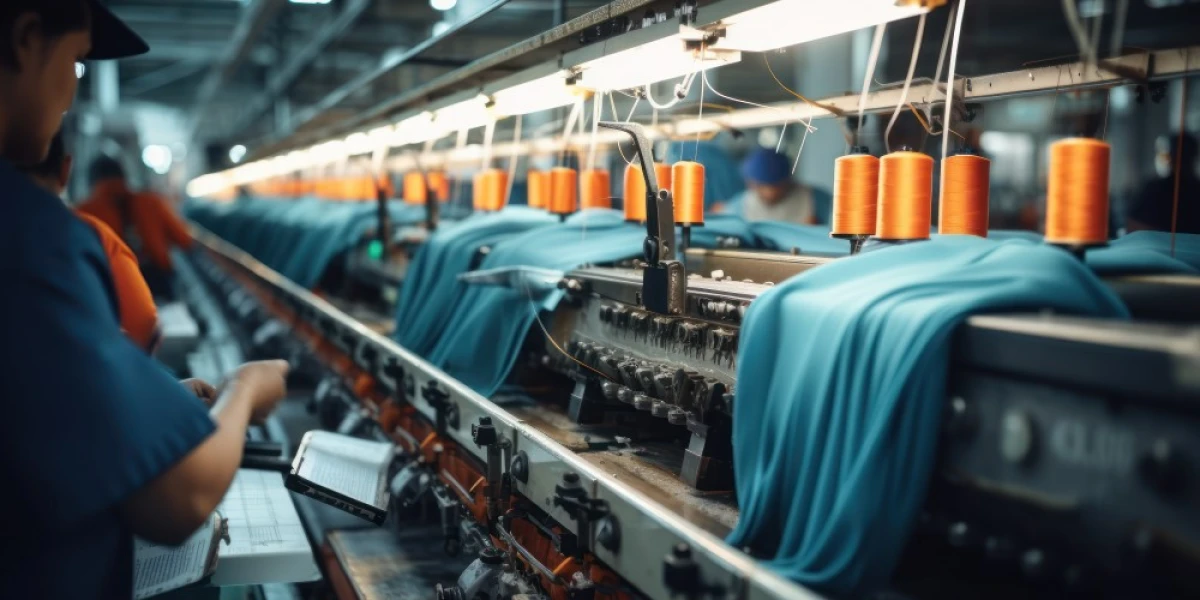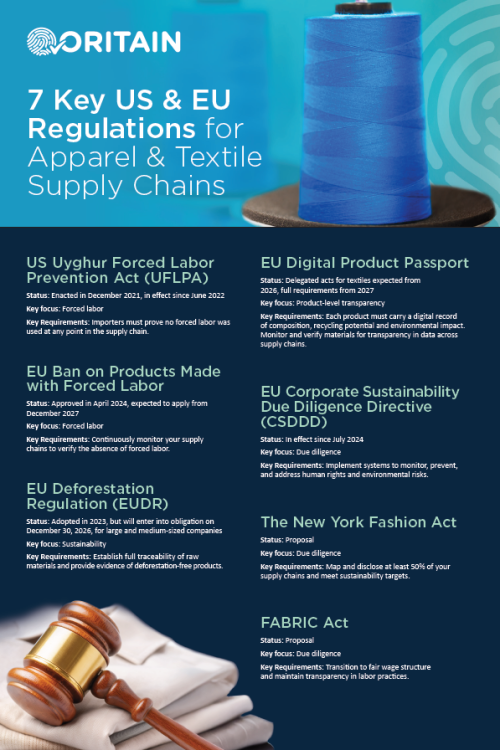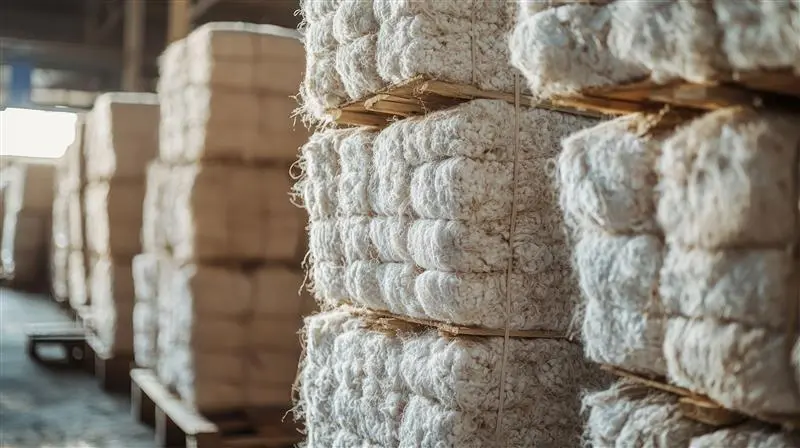7 Key US & EU Regulations for Apparel & Textile Supply Chains
By Ana Hinojosa | 20 August 2024
minutes to read.

New laws and regulations are compelling apparel and textile businesses to make major shifts to how they operate across the US and EU.
But do you know which regulations apply to your business to avoid non-compliance risks?
The repercussions of non-compliance can be severe – including hefty fines, reputational damage, and even legal action – making it non-negotiable to understand and comply with these regulations.
Download the global regulatory handbook to learn about all the current (and upcoming) legislation affecting the apparel and textile industry.
Contents:
- US Uyghur Forced Labor Prevention Act (UFLPA)
- EU Ban on Products Made with Forced Labor
- EU Deforestation Regulation (EUDR)
- EU Digital Product Passport (DPP)
- EU Corporate Sustainability Due Diligence Directive (CSDDD)
- The New York Fashion Act
- The FABRIC Act
- Key US & EU regulation summary infographic
1. US Uyghur Forced Labor Prevention Act (UFLPA)
The UFLPA, which came into effect in June 2022, mandates that any imported goods produced either wholly or in part in identified risk origin are presumed to be made using forced labor and therefore prohibited from entering the US market. The law, codified under the Tariff Act of 1930, places the burden of proof on importers to demonstrate that their goods are not produced using forced labor.
The UFLPA allows the U.S. Customs and Border Protection (CBP) to detain shipments without extensive investigations. Importers need to provide “clear and convincing evidence” that there was no forced labor in goods produced in identified risk origin or provide evidence that the goods are not produced in the banned region or by companies listed on the DHS UFLPA Entity List.
Section 307, even before UFLPA, prohibited the importation of cotton and cotton products from Xinjiang, Turkmenistan, and Uzbekistan, due to forced labor concerns, where CBP issued Withhold Release Orders (WROs) to detain suspect shipments, unless importers can prove they were produced without forced labor.
Since UFLPA came into effect, CBP has examined over 10,000 shipments valued at almost $3.7 billion, and 144 entities have been listed as presumed ineligible to import into the U.S. due to forced labor connections.
How to comply with the UFLPA?
- Map your supply chain to identify all regions and suppliers, especially origins of high-risk raw materials (like cotton)
- Prove no connection, financial or otherwise, with banned entities in your supply chain, including all tiers and subsidiaries
- Maintain ongoing, thorough traceability and documentation for every stage of sourcing and production
- Verify and prove no forced labor within the supply chain
- Verify raw materials like cotton are not from high-risk regions
Visit our UFLPA resources for more information.
2. EU Ban on Products Made with Forced Labor
On September 14, 2022, the EU Commission proposed a regulation to ban products made with forced labor from entering, exiting, or being sold in the EU market. The regulation received its final approval from the Parliament on April 23, 2024, and entered into force on December 14, 2024. However, the law will only be fully enforced starting December 14, 2027, to give companies three years to prepare.
The EU Ban on Products Made with Forced Labor applies to all sectors, products, and companies, regardless of where they are manufactured or exported, compelling companies to ensure their supply chains are free from forced labor in order to do business in the EU.
Authorities will investigate compliance through a two-phase process. The first phase includes a risk-based approach to assess potential violations, drawing on submissions from civil society, company records, and existing databases. If concerns arise, a full investigation will follow, and if evidence of forced labor is found, the products must be withdrawn and destroyed, and companies face penalties.
How to comply with the EU Ban on Forced Labor?
- Strengthen your due diligence and verification processes
- Maintain detailed and transparent records of your supply chain
- Identify, evaluate, and mitigate risks associated with high-risk origins
- Trust but independently verify your suppliers’ claims
3. EU Deforestation Regulation (EUDR)
Under the EUDR, only products sourced from land that has not been degraded or deforested after December 31, 2020, can be imported into or exported out of the EU. The law prohibits the trade of commodities such as leather, timber, rubber, wood, coffee, cocoa and more that are not deforestation-free, have not been produced in accordance with the relevant legislation of the country of production, and are not covered by a due diligence statement.
Operators and traders need to trace commodities back to their production plots and ensure deforestation compliance with laws on land use, labor rights, and human rights. Large and medium-sized companies will face enforcement from Dec. 30, 2026.
Businesses must conduct due diligence to verify that their products are deforestation-free, which involves collecting relevant data, preparing a Due Diligence Statement, and submitting it through a public system. The regulation places the burden of proof on importers and allows for penalties such as fines or product withdrawal if compliance is not demonstrated.
How to comply with the EUDR?
- Conduct thorough due diligence to prove your products and value chains are deforestation-free
- Gather and verify documentation to prove legal production and compliance with the EUDR
- Compile a due diligence statement, detailing country of origin and geolocation, and conduct annual reviews
- Eliminate risk from your forest product supply chains
Visit our EUDR resources for more information.
4. EU Digital Product Passport (DPP)
The DPP is a requirement under the EU’s Ecodesign for Sustainable Products Regulation. It requires all products placed on the European market to have a machine-readable product passport, such as a QR code or NFC chips, which is linked to a unique product ID. This digital record will store information about a product’s environmental footprint throughout its lifecycle, from raw materials and origin, to composition, carbon footprint, certifications, repairability, recyclability, and more.
This information will be accessible to consumers, supply chain partners, and regulators through a dedicated web portal.
EU authorities can perform checks on imported products to validate that Passports exist and that they are both current and authentic.
Textiles are among the first product groups scheduled for implementation, with delegated acts expected from 2026 and full requirements applying from 2027 onward. Brands selling into the EU must prepare to collect and maintain verified data at the fiber and components level, and onboard suppliers onto unified traceability platforms.
How to comply with the DPP?
- Map the full supply chain for each product and collect verified material and processing data from suppliers
- Work with technology partners to implement QR codes or NFC chips on all new products
- Build a central digital system to store and manage product information
- Regularly train suppliers and staff on requirements for data gathering, traceability, and reporting
- Review and update DPP data when products are repaired, resold, or otherwise change hands
- Monitor EU regulatory updates and deadlines to ensure all processes and records meet evolving requirements
5. EU Corporate Sustainability Due Diligence Directive (CSDDD)
The European Council passed the CSDDD (also referred to as CS3D) in March 2024 requires companies operating in Europe to identify, mitigate and remedy environmental and human rights violations in their own operations, subsidiaries, or supply chain partners. It applies to EU companies with more than 5000 employees and turnover of €1.5B and non-EU companies are in scope if they exceed €450m EU turnover.
Companies are expected to review the effectiveness of their due diligence processes at least every five years or sooner if triggered by new information or complaints. Each company has to determine which stakeholders are relevant for engagement, with a primary focus on direct (tier one) suppliers.
Enforcement of the CSDDD will be determined by individual Member States, with sanctions including financial penalties based on annual turnover and civil liability to make sure victims receive compensation for damages resulting from non-compliance.
How to comply with the CSDDD?
- Implement systems to manage supply chain risk and monitor and prevent violations of human rights and environmental impacts across your supply chain
- Assess both upstream and downstream activities within your value chains
- Take corrective action to remediate any identified violations to avoid liability
- Prepare for potential financial penalties and civil liabilities for non-compliance
Download our CSDDD whitepaper for more information.
6. The New York State Fashion Sustainability and Social Accountability Act
The New York Fashion Act seeks to hold major fashion businesses accountable for their environmental and social impacts. It targets fashion brands and retailers conducting business in New York and generating over $100 million in global annual income.
While the Act has not yet passed into law, it’s gaining support from brands, NGOs and celebrities.
How to comply with the Fashion Act?
Fashion brands and retailers conducting business in New York and generating over $100 million in annual global income must:
- Map and disclose at least 50% of your manufacturers and suppliers by volume across all tiers
- Set and achieve science-based targets for energy usage, greenhouse gas emissions, water, and chemicals
- Report the amount of product produced based on material type
- Prepare for potential fines of up to 2% of annual revenues for non-compliance
7. The FABRIC Act
The FABRIC Act, reintroduced by Senator Kirsten Gillibrand and Congressman Jerrold Nadler, aims to improve conditions for U.S. garment workers by addressing the misuse of piece-rate pay and enhancing domestic apparel manufacturing. The Act attempts to create a $50 million annual support program through the Department of Labor, which will provide grants and technical assistance to manufacturers while holding brands accountable for their labor practices.
How to comply with the FABRIC Act?
To comply with the FABRIC Act, manufacturers and brands should consider the following steps:
- Transition from piece-rate pay to a consistent wage structure
- Participate in the support program for grants and technical assistance for facility upgrades and training
- Maintain transparency in labor practices and establish accountability measures for manufacturing partners
- Create training and workforce development programs for employees to enhance skills and safety
- Register with the newly established garment industry registry to follow minimum labor standards
Key US & EU regulation summary infographic
The following infographic summarizes seven key regulations affecting the apparel and textiles industry. Click the image to view a larger version and download the infographic.
Got questions about these regulations or want to know more about how you can comply with the current and upcoming regulations? Connect with one of our experts today.
Disclaimer: The information provided in this document does not and is not intended to constitute legal advice. Instead, all information presented here is for general informational purposes only. Counsel should be consulted with respect to any particular legal situation.





